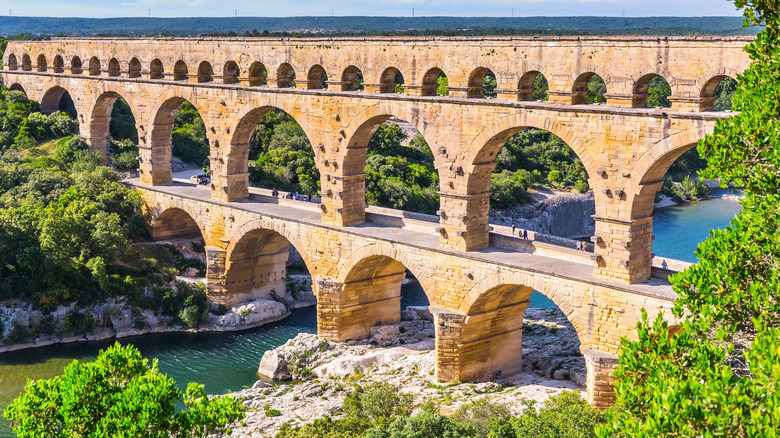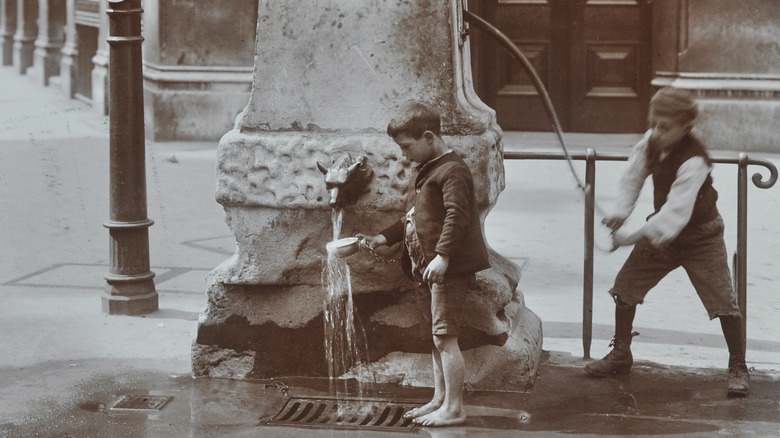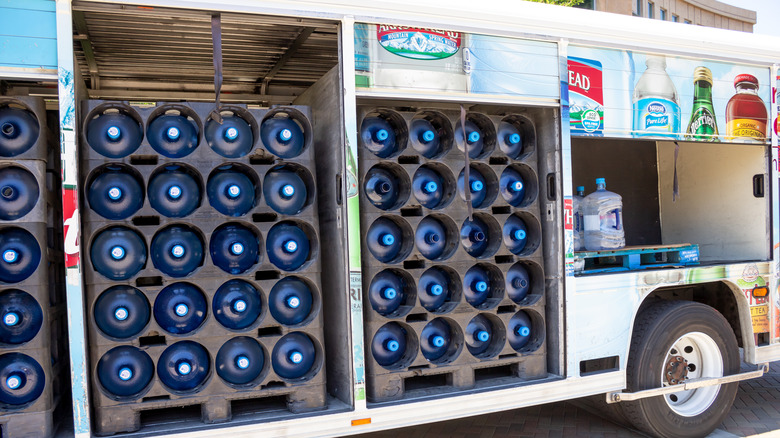How The Water Cooler Was Invented
With many offices offering coolers to provide chilled drinking water, gathering around the water cooler has become a symbol of modern life. Common phrases like "water cooler gossip" and "water cooler jokes" attest to the fact that the water cooler is where people come together and socialize in person, in an era when many work in cubicles and socialize online. Beyond its social impact, on its most basic level, the water cooler is also a place where people go to get water.
Even today, one person in 10 around the world lacks access to safe drinking water (per the Water.org website). Since the story of the water cooler is also the story of drinking water itself, the chronicle of its invention starts back thousands of years ago, when people started filtering water in order to safely drink it. While some water filtration methods have fallen by the wayside, other ancient methods — such as filtering water through sand — are still around today.
It started in Asia
The first recorded method to filter water came from southeast Asia. According to the book "The Quest for Pure Water" by M.N. Baker and Michael Taras (via Free Drinking Water), it was a Sanskrit medical text from the 15th Century B.C. that detailed the first known method to prepare water for drinking. That involved boiling water, allowing it to sit in the sun, then filtering it through layers of gravel and sand.
Using gravel and sand to filter water was also used across several other cultures. The Egyptians invented a device to filter water through sand, and the complex-looking mechanism is portrayed on the tomb walls of Amenophis II and Rameses II from the 15th and 13th Centuries B.C. The Greeks not only filtered water through sand but also through a cloth bag called the "Hippocrates sleeve," named after its inventor Hippocrates, the father of medicine himself.
Carrying water
The Romans' contribution to the history of drinking water was their ability to transport water from mountain springs to the cities. They did this by building aqueducts, according to National Geographic. Though the Romans were not the first to build aqueducts, which had already been used in Egypt and India, they improved the structure to cover more ground throughout the vast Roman Empire. Aqueducts lined with copper or marble connected springs and freshwater lakes to cities, to be used for drinking, farming, and bathing. Some Roman aqueducts, built between 312 B.C. and 226 A.D., are still in use today.
The Khmer Empire of Ankhor (current day Cambodia) also found effective ways to move water where it was needed, building water channels, reservoirs, and embankments, according to JSTOR Daily. These massive waterworks projects, built between the ninth and 13th centuries A.D., not only brought drinking water to the cities; they also irrigated the fields and protected residents from overflows during monsoon rains.
On the South American continent, the Incas, the Mayans, and the Aztecs also built massive aqueducts, connecting scarce mountainous water sources to the people in cities. According to Blurred Bylines, the aqueducts transporting water to the Aztec capital city of Tenochtitlan were cleaned regularly, so as not to transport disease. Though there is no written record of the building of the aqueducts, the structures were around when the Spanish Conquistadors wrote about them in the 16th century. According to Real Archaeology, some aqueducts are still in use today.
Clean water for all
With the rise and fall of each ancient empire, public water systems also rose and fell. The collapse of the Roman Empire meant the end of water infrastructure in Europe as they knew it. The so-called Dark Ages (approximately 500-1500) were rife with diseases like cholera and typhoid, as people drank from non-treated lakes and rivers, according to the Edgar's Water Company blog.
Scotland developed the first municipal water purification system in 1804, according to Free Drinking Water, filtering the water through gravel and sand, then distributing it across town by horse and cart. A similar method was adopted the next century in London, after it became clear that there was a relationship between contaminated water and cholera. Parliament passed the Metropolitan Water Act in 1852, requiring all water in the city to be filtered. Municipal water filtration systems are so common now, they only make the news when they break down and allow contaminants into the drinking water supply, as was the case in Flint, Michigan in 2014-2015, when the water was found to have e-coli, carcinogens, and high levels of lead. (via NPR)
How a tin cup inspired a new invention
As important as it is to have access to clean water, it is just as important to have a clean way to dispense it. Luther Haws was a sanitary inspector in Berkeley, California when he saw public school children sharing and drinking from the same cup in a public school in 1905, according to American Profile. This inspired Haws to invent a more sanitary way to share water in public spaces, and within four years he had invented the first water fountain, in 1909.
Hawes went on to invent the first self-contained water cooler in 1938, according to the Edgar's Water Company blog. It differed from the water fountain, mainly in that the water was not piped in, but was dispensed from a large glass bottle. The device used electricity to cool the water, and was similar to today's water coolers, except the heavy glass bottles (sometimes called carboys, or demijohns) were replaced by lighter plastic bottles in the 1980s. Now some water coolers even dispense hot water, to the delight of tea drinkers.
Water cooler conversation
Speaking of water, it was the Greek philosopher Heraclitus who said, "No man ever steps in the same river twice, for it's not the same river and he's not the same man." Translation: Things are always changing. Even though humans still clean their water before drinking, some of the methods have changed. And even though we transport water from the springs and reservoirs into settlements, some of those modes of transportation have changed, too. The water in the office cooler comes not via aqueduct, but by truck from bottling facilities.
The next time you're at the water cooler wracking your brain for a good joke to tell or some nice harmless gossip to engage in, take a moment to appreciate the water itself. Think of water treatment methods old and new, and the work that goes into distributing clean water across the globe, whether it be by municipal pipe, truck, horse and cart, or aqueduct. Think of the tin cup that inspired the invention you're gathering around. Maybe all this would even make good water cooler conversation.





